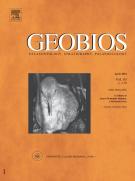The carnivoran guilds from the Late Miocene hominid locality of Hammerschmiede (Bavaria, Germany) - 03/08/24
 , Alberto Valenciano d, e, Juan Abella f, g, h, Michael Morlo i, George E. Konidaris a, j, Panagiotis Kampouridis a, j, Thomas Lechner a, j, Madelaine Böhme a, j
, Alberto Valenciano d, e, Juan Abella f, g, h, Michael Morlo i, George E. Konidaris a, j, Panagiotis Kampouridis a, j, Thomas Lechner a, j, Madelaine Böhme a, jAbstract |
The Late Miocene locality of Hammerschmiede has yielded an astonishing diversity of vertebrates, including 28 different carnivoran species. The main layers HAM 5 (11.62 Ma) and HAM 4 (11.44 Ma) have been found to host 21 and 17 carnivoran species, respectively. Herein we perform a guild structure analysis aiming to unravel their ecomorphological role. A rarefaction analysis showed that such a high representation of carnivorans is comparable only to the fissure fillings of La-Grive-Saint-Alban. The First and Last Occurrence Dates of several genera and species are reported in the locality. The profile of the locality concerning the Numbers of Species and Individuals per family is unique among the Miocene localities of Europe. The discovered carnivorans were attributed to palaeoecological categories based on their body mass, locomotor pattern, and diet preferences. Ecomorphological comparison revealed that most species were able to reduce competition by occupying different ecological niches, but some cases of ecological overlap were found. This shows that the ecosystem of Hammerschmiede offered diverse resources that allowed the subsistence of a plethora of carnivorans. Finally, the two main layers exhibit some differences in their carnivoran components, with HAM 4 dominated by small-/medium-sized piscivores/generalist carnivores, whereas HAM 5 also includes large-sized durophagous/hypercarnivorous forms.
El texto completo de este artículo está disponible en PDF.Keywords : Carnivora, Ecology, Miocene, Neogene, Europe
Esquema
| ☆ | Corresponding editor: Rosalía Guerrero-Arenas. |
Bienvenido a EM-consulte, la referencia de los profesionales de la salud.
El acceso al texto completo de este artículo requiere una suscripción.
¿Ya suscrito a @@106933@@ revista ?

